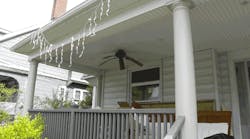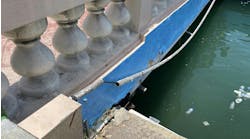Here we see an all-too-common violation of the requirements set forth in 590.3(B). This section of the Code says, "Temporary electric power and lighting installations shall be permitted for a period not to exceed 90 days for holiday decorative lighting and similar purposes." Given the fact that this picture is of a house in the northeastern United States — and the trees are in full bloom — it’s safe to assume that the 90-day limit imposed by this Code rule has been exceeded. As such, the "icicle" lighting string should have been removed at some point prior to the time when this picture was taken.
Find the Answer
Although this is a very common violation, it's rare that a property owner — whether the occupancy is classified residential or commercial — is cited for failure to remove Christmas lighting within the prescribed time frame. This reality is a function of enforcement. Third-party inspection agencies have no authority to go on private property, unless invited, and inspectors for municipal building departments are either not aware of the rule or not concerned.
It's worth noting that the "hard-and-fast" 90-day limit placed on seasonal lighting is the only instance where the Code places any time constraint on "temporary installations" for light and power. The other referenced applications in Sec. 590.3 focus on are permitted to be used as long as needed. However, as noted in part (D) of this rule, "Temporary wiring shall be removed immediately upon completion of construction or purpose for which the wiring was installed." This wording essentially requires temporary wiring to be removed as soon as possible.
This is a "make-sense" proposition, because, as we know, the installation requirements in Art. 590 are less stringent than those given for permanent wiring. While such relaxing of the general requirements is needed during those instances identified in Sec. 590.3, it’s not the safest — especially where the general public has access to the location — and it should only be used as long as absolutely needed.



